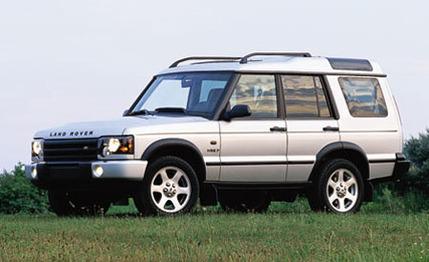
 Short Take Road Test
Short Take Road Test


There may not be a Car and Driver branch at the Brookings Institution, but nonetheless we've had our own Ann Arbor-headquartered think tank whirring away for years. We've tackled an amazing array of diverse questions, such as "Why didn't Csaba's parents name him Jim?" Long ago our intellectual firepower concluded that sport-ute owners rarely, if ever, take their four-wheelers off-road.
Although we are the mentally challenged bunch that once encouraged a cross-country open-road race, the Cannonball, and built a twin-engine Honda CRX, we're still sharp enough to do most of our sport-ute comparing where these vehicles will spend the vast majority of their time: on the road. Off-road ability gets mentioned but rarely sways the final vote. Land Rover's outgoing Discovery has not fared well. In its last C/D comparison (December 2000), it finished seventh of seven. Land Rover is quick to point out that the Discovery can go places no other vehicle in its class could dream of tackling, just as the Porsche 911 has a higher top speed than many of its rivals, never mind that ordinary drivers seldom probe either of these capabilities.
Land Rover may have a small point, but the fact remains that sport-utes are getting cushier. In fact, most of them are more like tall station wagons than trucks. The Discovery Series II was no station wagon, but its on-road manners left room for improvement. And that's exactly the aim of the changes Land Rover has made for 2003: a new engine and transmission and several detail improvements.
The engine is the 4.6-liter V-8 that used to reside in the Range Rover. It makes 217 horsepower and a healthy 300 pound-feet of torque. Although this V-8 is no match for a GM small-block, it is a much-appreciated bump up from the old 188-hp, 3.9-liter engine it replaces.
In addition, there are detail improvements to the chassis and body. To reduce head toss and refine ride quality, the shocks were recalibrated with increased damping. Land Rover says it's made several advancements in sound deadening and found better ways to mount the interior trim panels and dash to reduce squeaks and rattles. In all, there have been 368 engineering changes for 2003.
Do these changes make the Discovery as slick on the road as an Acura MDX? Well, no, but they do help. Although there is still a great deal of wind noise at 80 mph, now the Discovery doesn't feel strained to hold that speed. Passing on two-lanes used to be a sketchy move; now it's a definite option. Acceleration is hardly sprightly, but it is improved. We found the Discovery needed 10.1 seconds to reach 60 mph, a 1.3-second improvement over the old car and 1.7 seconds behind the MDX. Getting from 50 to 70 mph now takes 7.1 seconds, 0.7 second better than before.
We also recorded 0.74 g on the skidpad, the same as the old vehicle. Our tester was equipped with the $1700 Active Cornering Enhancement rear roll control. This basically consists of a hydraulic mechanism that's mounted in the middle of the rear anti-roll bar and can adjust the bar's stiffness. Its job is to reduce the amount of body lean when cornering, and it works brilliantly. With it, you won't forget you're in a tall 5027-pound vehicle, but the Disco and its high center of gravity don't feel as tippy as you might expect.
The bottom line is that Discovery owners can now have the rough-and-tumble image with a little less of the old model's truckiness. None of the changes diminishes the Disco's off-road worthiness. In fact, for 2003 Land Rover added standard Hill Descent Control, a feature that makes for extremely calm runs on steep off-road downhills. During the press intro, we took a Discovery over slick, steep, rock-strewn trails, and the full-time four-wheel-drive system and standard traction control handled them with ease. With generous approach and departure angles (31 and 21 degrees on our test car; 31 and 25 with the optional rear air springs), none of the body parts dragged. Could some of the other utes have made it? Probably. But we bet many of them would have dragged and perhaps damaged some portion of their bodies.
We're not sure if the better road manners and retained off-road ability make the Disco the favorite in the class, but it does have a lot going for it: optional seven-passenger seating, dual climate controls, and one of the most commanding views from any sport-ute. Prices are just a smidge higher. The base S model starts at $34,995, and our top-of-the-line HSE7 started at $40,995. One thing's for sure: The Disco is no poseur, and in a world of tall station wagons masquerading as trucks, that's worth something.